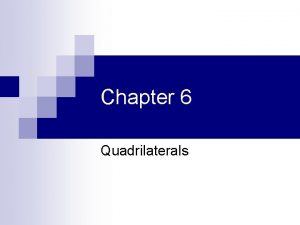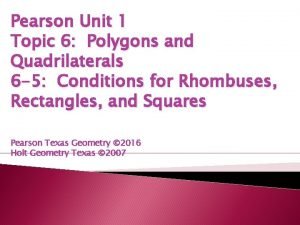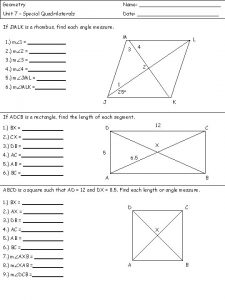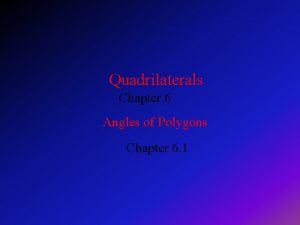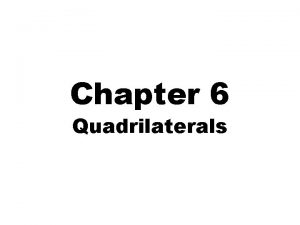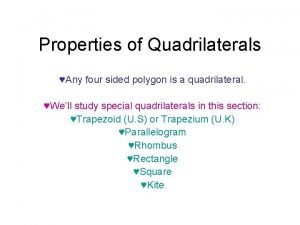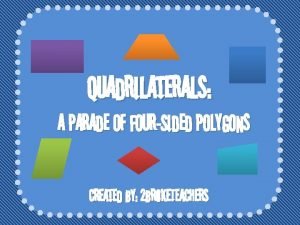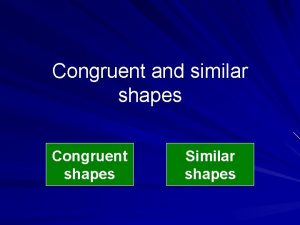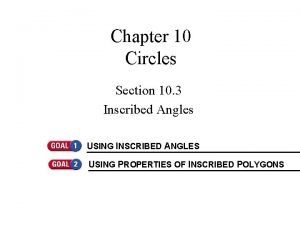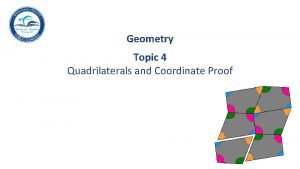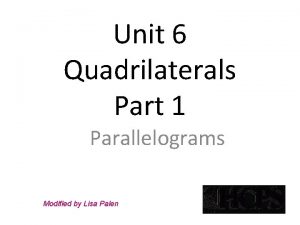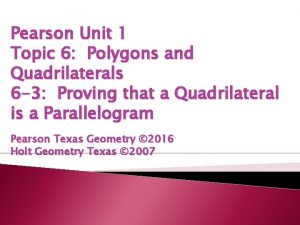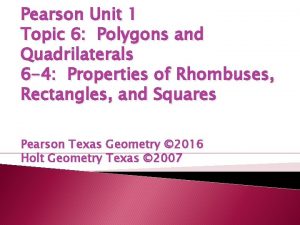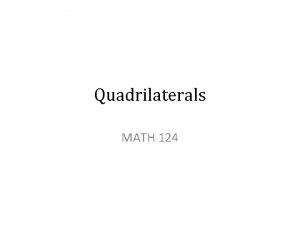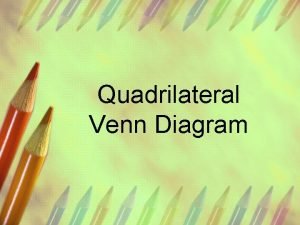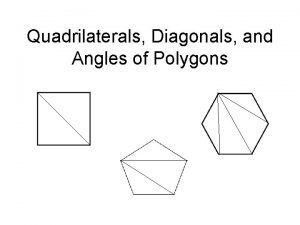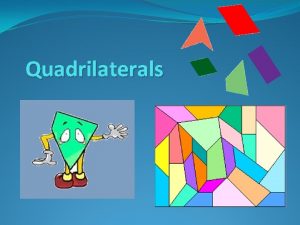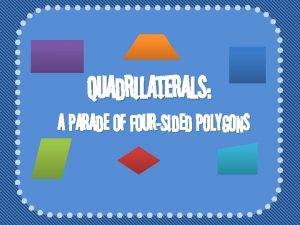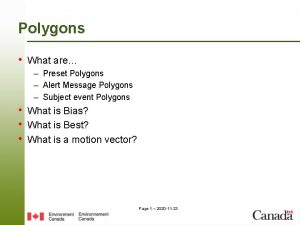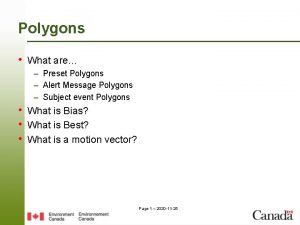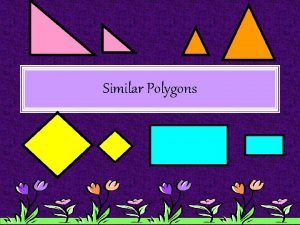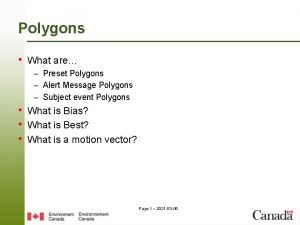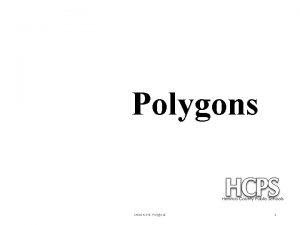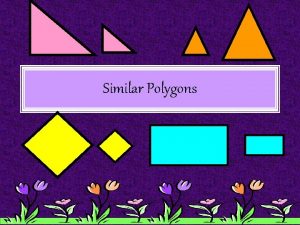Pearson Unit 1 Topic 6 Polygons and Quadrilaterals















- Slides: 15

Pearson Unit 1 Topic 6: Polygons and Quadrilaterals 6 -2: Properties of Parallelograms Pearson Texas Geometry © 2016 Holt Geometry Texas © 2007

�TEKS Focus: �(6)(E) Prove a quadrilateral is a parallelogram, rectangle, square, or rhombus using opposite sides, opposite angles, or diagonals and apply these relationships to solve problems. �(1)(F) Analyze mathematical relationships to connect and communicate mathematical ideas. �(1)(G) Display, explain, or justify mathematical ideas and arguments using precise mathematical language in written or oral communication.

Any polygon with four sides is a quadrilateral. However, some quadrilaterals have special properties. These special quadrilaterals are given their own names. Helpful Hint Opposite sides of a quadrilateral do not share a vertex. Opposite angles do not share a side.

A quadrilateral with two pairs of parallel sides is a parallelogram. To write the name of a parallelogram, you use the symbol.



Example: 1 Answer: C Consecutive angles in a parallelogram are supplementary.

Example: 2 CDEF, DE = 74 mm, DG = 31 mm, and m FCD = 42°. Find CF , DF, and m EFC. In opp. sides diags. DF = 2 DG bisect each other. CF = DE Def. of segs. DF = 2(31) Substitute 31 for DG. CF = 74 mm Substitute 74 for DE. DF = 62 Simplify. m EFC + m FCD = 180° m EFC + 42 = 180 m EFC = 138° consecutive s supp. Substitute 42 for m FCD. Subtract 42 from both sides.

Example: 3 In KLMN, LM = 28 in. , LN = 26 in. , and m LKN = 74°. Find KN, LO, and m NML. opp. sides LM = KN Def. of segs. LM = 28 in. Substitute 28 for DE. LN = 2 LO diags. bisect each other. 26 = 2 LO Substitute 26 for LN. LO = 13 in. Simplify. NML LKN opp. s m NML = m LKN Def. of s. m NML = 74° Substitute 74° for m LKN.

Example: 4 WXYZ is a parallelogram. Find YZ and m Z. opp. s YZ = XW 8 a – 4 = 6 a + 10 2 a = 14 a=7 Def. of segs. Substitute the given values. Subtract 6 a from both sides and add 4 to both sides. Divide both sides by 2. YZ = 8 a – 4 = 8(7) – 4 = 52

Example: 4 continued m Z + m W = 180° (9 b + 2) + (18 b – 11) = 180 27 b – 9 = 180 27 b = 189 b=7 consecutive s supp. Substitute the given values. Combine like terms. Add 9 to both sides. Divide by 27. m Z = (9 b + 2)° = [9(7) + 2]° = 65°

Example: 5 EFGH is a parallelogram. Find JG and FH. diags. bisect each other. EJ = JG Def. of segs. 3 w = w + 8 Substitute. Simplify. 2 w = 8 Divide both sides by 2. w=4 JG = w + 8 = 4 + 8 = 12

Example: 5 continued diags. bisect each other. FJ = JH Def. of segs. Substitute. Simplify. z = 4. 5 Divide both sides by 2. 4 z – 9 = 2 z 2 z = 9 FH = (4 z – 9) + (2 z) = 4(4. 5) – 9 + 2(4. 5) = 18

Example: 6 STATEMENT 1. ABCD, AK MK REASON 1. Given 2. BCD A 2. Opposite ’s in a are 3. A CMD 3. If two sides of ∆ are then ’s opposite those sides are 4. BCD CMD 4. Transitive Property

Example: 7 Find the values of x and y in Parallelogram PQRS. Find PR and SQ. y=x+1 2 x = 3 y – 7 2 x = 3 (x + 1) – 7 2 x = 3 x + 3 – 7 2 x = 3 x – 4 -1 x = -4 x=4 y=4+1=5 PR = 16 SQ = 10
 Topic 6 quadrilaterals and other polygons answers
Topic 6 quadrilaterals and other polygons answers Topic 6 quadrilaterals and other polygons answers
Topic 6 quadrilaterals and other polygons answers Special quadrilaterals
Special quadrilaterals Measure of one exterior angle of a pentagon
Measure of one exterior angle of a pentagon Is a kite a rhombus?
Is a kite a rhombus? 4 sided polygons
4 sided polygons Area of four sided polygon
Area of four sided polygon Which of these shapes is congruent to the given shape?
Which of these shapes is congruent to the given shape? Section 10 topic 3 inscribed polygons in a circle
Section 10 topic 3 inscribed polygons in a circle A clincher sentence is
A clincher sentence is Topic about internet
Topic about internet Coordinate proof (quadrilaterals)
Coordinate proof (quadrilaterals) Examples of parallelogram
Examples of parallelogram Family of quadrilaterals
Family of quadrilaterals Pearson education 2011
Pearson education 2011 Pearson education 2011
Pearson education 2011
